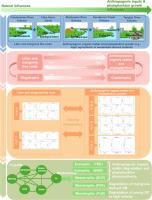Dynamics of blue carbon across various estuaries: Key drivers and pathways
IF 12.4
1区 环境科学与生态学
Q1 ENGINEERING, ENVIRONMENTAL
引用次数: 0
Abstract
Coastal wetlands are vital organic carbon (OC) sinks. This study examined OC dynamics and the implications for trophic status in the salt marsh-dominated Yangtze River Estuary (YRE) in China and four mangrove-dominated estuaries under varying anthropogenic influence within the Rookery Bay National Estuarine Research Reserve (RBNERR) in the USA, including natural (FHE), agricultural (BWE), canal-modified (FUE), and urbanized (HCE) estuaries. The research focused on three thematic areas: total organic carbon (TOC) composition and degradation, key drivers and their cascading effects, and estuarine eutrophication assessment, employing stable isotope tracing (δ13C, C/N), machine learning (BRT models), partial least squares path modeling (PLS-PM), and trophic indices (TRIX, TSI). Results showed that FHE had the highest organic carbon concentrations (4-19.82 mg/L). While terrestrial sources contributed >85% of total OC across estuaries, composition varied: YRE's OC was derived mainly from freshwater algae and soil organic matter, whereas in the RBNERR estuaries, it was dominated by mangrove-derived, marine phytoplankton, and anthropogenic sources. Anthropogenic organic matter (OM) inputs (e.g., from agriculture and wastewater) and phytoplankton growth promoted r-strategists and enhanced degradation, likely decreasing burial efficiency in YRE, BWE, and HCE compared to FHE and FUE. In the FHE and FUE, TOC was primarily driven by the degradation of mangrove-derived OM (with hydrodynamic influence in FUE). In contrast, TOC in the YRE, BWE, and HCE estuaries was mainly governed by anthropogenic and phytoplankton inputs, which manifested in distinct ways: tidal dilution, light-limited photosynthetic growth, and degradation of phytoplankton-derived and soil organic matter in the YRE; agricultural organic matter degradation in the BWE; and phytoplankton photosynthesis in the HCE. PLS-PM further revealed that meteorological factors indirectly influenced TOC concentrations through salinity, biological environment, hydrodynamics and nutrients. Overall, the driving mechanisms resulted in the YRE and BWE being eutrophic, while the other estuaries were mesotrophic. In summary, these findings demonstrate that local environmental factors and human activities are key drivers of OC dynamics. This understanding of specific mechanisms is essential for refining blue carbon assessments under global change.

不同河口蓝碳动态:关键驱动因素和途径
沿海湿地是重要的有机碳汇。研究了中国盐沼为主的长江口(YRE)和美国鸦巢湾国家河口研究保护区(RBNERR)内四个红树林为主的河口在不同人为影响下的OC动态及其营养状况的影响,包括自然河口(FHE)、农业河口(BWE)、运河改造河口(FUE)和城市化河口(HCE)。采用稳定同位素示踪(δ13C、C/N)、机器学习(BRT模型)、偏最小二乘路径建模(PLS-PM)和营养指数(TRIX、TSI),研究了三个主题领域:总有机碳(TOC)组成和降解、关键驱动因素及其级联效应以及河口富营养化评估。结果表明,FHE有机碳浓度最高(4 ~ 19.82 mg/L);尽管陆源占河口总OC的85%,但其组成各不相同:YRE的OC主要来自淡水藻类和土壤有机质,而RBNERR河口的OC主要来自红树林、海洋浮游植物和人为来源。人为的有机物(OM)输入(例如来自农业和废水)和浮游植物的生长促进了r-策略性并增强了降解,与FHE和FUE相比,可能降低了YRE、BWE和HCE的掩埋效率。在FHE和FUE中,TOC主要由红树林来源的OM退化驱动(在FUE中受水动力影响)。相比之下,长江三角洲、BWE和HCE河口TOC主要受人为和浮游植物输入的控制,其表现方式不同:潮汐稀释、限光光合生长、长江三角洲浮游植物源和土壤有机质的降解;BWE农业有机质降解;以及HCE中的浮游植物光合作用。PLS-PM进一步揭示了气象因子通过盐度、生物环境、水动力和养分间接影响TOC浓度。总体而言,YRE和BWE的驱动机制是富营养化的,而其他河口是中营养化的。综上所述,当地环境因子和人类活动是有机碳动态的主要驱动因素。这种对具体机制的理解对于完善全球变化下的蓝碳评估至关重要。
本文章由计算机程序翻译,如有差异,请以英文原文为准。
求助全文
约1分钟内获得全文
求助全文
来源期刊

Water Research
环境科学-工程:环境
CiteScore
20.80
自引率
9.40%
发文量
1307
审稿时长
38 days
期刊介绍:
Water Research, along with its open access companion journal Water Research X, serves as a platform for publishing original research papers covering various aspects of the science and technology related to the anthropogenic water cycle, water quality, and its management worldwide. The audience targeted by the journal comprises biologists, chemical engineers, chemists, civil engineers, environmental engineers, limnologists, and microbiologists. The scope of the journal include:
•Treatment processes for water and wastewaters (municipal, agricultural, industrial, and on-site treatment), including resource recovery and residuals management;
•Urban hydrology including sewer systems, stormwater management, and green infrastructure;
•Drinking water treatment and distribution;
•Potable and non-potable water reuse;
•Sanitation, public health, and risk assessment;
•Anaerobic digestion, solid and hazardous waste management, including source characterization and the effects and control of leachates and gaseous emissions;
•Contaminants (chemical, microbial, anthropogenic particles such as nanoparticles or microplastics) and related water quality sensing, monitoring, fate, and assessment;
•Anthropogenic impacts on inland, tidal, coastal and urban waters, focusing on surface and ground waters, and point and non-point sources of pollution;
•Environmental restoration, linked to surface water, groundwater and groundwater remediation;
•Analysis of the interfaces between sediments and water, and between water and atmosphere, focusing specifically on anthropogenic impacts;
•Mathematical modelling, systems analysis, machine learning, and beneficial use of big data related to the anthropogenic water cycle;
•Socio-economic, policy, and regulations studies.
 求助内容:
求助内容: 应助结果提醒方式:
应助结果提醒方式:


